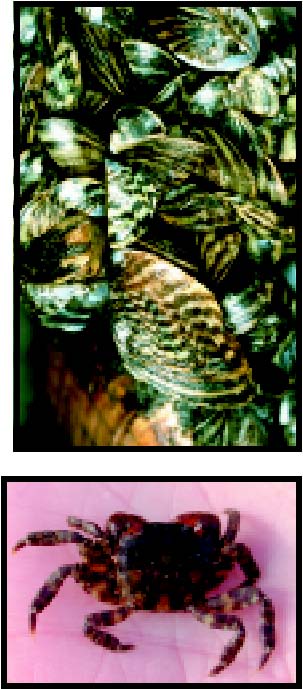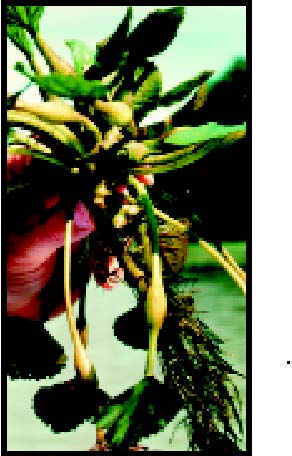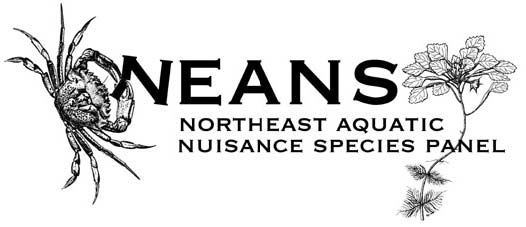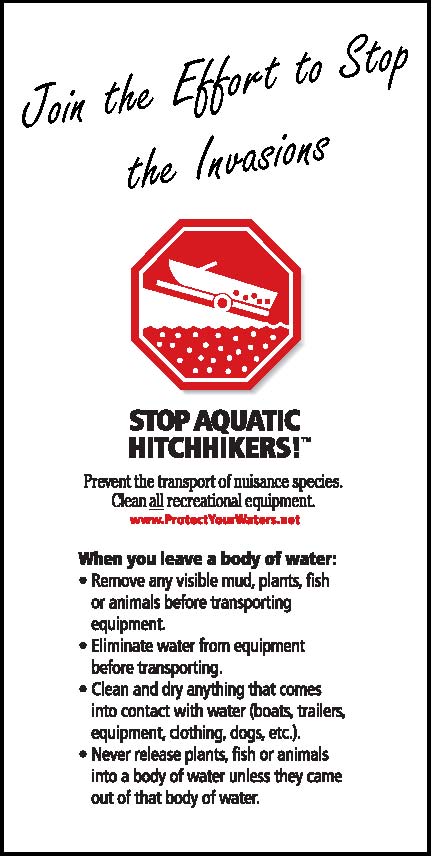|
















| |

AQUATIC NUISANCE
SPECIES
HARM NORTHEAST REGION
The Problem
Waters of northeastern North America
are feeling the effects of invasive aquatic plants and animals
transplanted from around the world. These organisms, introduced both
intentionally and accidentally, can irrevocably alter our native
ecosystems. Once “invaders” establish in a new ecosystem absent the
control of their native predators, they can harm native species by
preying on them, eating their food, transmitting diseases,
outcompeting with them for habitat, or by simply outgrowing them.
Entire ecosystems may be disrupted by habitat destruction or altered
food chains. Not all non-native plants and animals cause serious
problems, but those that do are known as invasive aquatic nuisance
species or ANS.
The Effect
- Each
year in North America, federal, state, and provincial governments,
utilities, and businesses spend billions of dollars
attempting to prevent, control or slow the spread of ANS.
- $500,000 is spent annually to manage and
prevent the lakewide spread of water chestnut in Lake Champlain on
the Vermont / New York border. Water chestnut has also been found
in Massachusetts and Connecticut.
- A 1999 Cornell University study estimates a
$44 million per year economic loss to New England and the Canadian
Maritime Provinces due to predation on commercially valuable
shellfish by the introduced European green crab.
- An economic study in New Hampshire showed that
the value of property adjacent to lakes choked with aquatic weeds
like Eurasian water milfoil is reduced by 15% or more. Invasive
aquatic weeds are found in lakes throughout the Northeast region.
- The State of Florida spends millions of
dollars annually on herbicides and mechanical harvesters in an
effort to keep the invasive aquatic plant, hydrilla, under
“maintenance control.” Hydrilla has been found in both Connecticut
and Massachusetts, and is anticipated to be able to grow as far
north as the U.S./ Canadian border.
- A pilot voluntary inspection program conducted
by the State of Maine found more than 1,200 boats transporting
aquatic weeds around the state, which could easily lead to
numerous new infestations. Hundreds of thousands of recreational
boats move throughout the Northeast annually.
- Zebra mussels in the Great Lakes region have
cost nuclear power plants an average of $800,000 annually for
control. Even smaller municipalities in affected areas spend about
$20,000 per
year on control efforts. In the Northeast,
zebra mussels are currently found in New York, Vermont,
Connecticut, and Quebec.
- A South American strain of human cholera
bacteria was found in ballast tanks in the port of Mobile, Alabama
in 1991. Cholera strains were also found in shellfish samples,
resulting in a


public health advisory against the consumption of raw shellfish.
�What
is being done about ANS in the Northeast?

who we are... what we do...
The Northeast Aquatic Nuisance Species
(NEANS) Panel was established in 2001, the fourth regional panel to be
established under the auspices of the federal Aquatic Nuisance Species
Task Force (ANSTF), following the Great Lakes, Western Regional, and
Gulf of Mexico panels. The mission of the panel is to “protect the
marine and freshwater resources of the Northeast from invasive aquatic
nuisance species through commitment and cohesive coordinated action.”
Using regional cooperative approaches, like the panels, to address
this trans-boundary problem is extremely important to foster and
ensure interstate coordination of effort, and to make the most
effective use of resources.
The NEANS Panel addresses issues and concerns
relative to the freshwater and marine resources of the states of
Maine, New Hampshire, Vermont, Massachusetts, Rhode Island,
Connecticut, and New York, and the Canadian provinces of Quebec, New
Brunswick, and Nova Scotia. The panel’s members represent state,
federal, and provincial governments, academia, commercial and
recreational fishing interests, recreational boaters, commercial
shipping, power and water utilities, environmental organizations,
aquaculture, nursery and aquarium trades, tribal concerns, lake
associations, and the bait industry, among others.
The panel has three working committees: policy and
legislation, science and technology, and communications, education,
and outreach. In addition, the panel’s steering committee is headed by
freshwater and marine co-chairs.
For more information on the NEANS Panel, please
contact Michele Tremblay in the U.S. at 603-796-2615 or Lara Gibson in
Canada at 902-429-2202, or send an email to: info@NortheastANS.org
Visit our Website
<www.NortheastANS.org>
Produced by
the Communications, Education, and Outreach Committee, NEANS Panel,
2002. TEXT CREDITS: Many thanks to the Western Regional Panel for
permission to use text from their “Threats to the West” brochure.
PHOTO CREDITS: (front) water chestnut, Ann Bove, VTDEC; zebra
mussels, National Aquatic Nuisance Species Clearinghouse; Asian
shore crab, Nancy Balcom, CT Sea Grant.

WHAT ELSE CAN
YOU DO TO HELP?
You
can help prevent the spread of aquatic nuisance species by
following these guidelines:
- Report sightings to your state/provincial
natural resources or environmental protection agency, Sea Grant,
U.S. Fish and Wildlife Service, Environment Canada, or Fisheries
and Oceans Canada.
Learn more about non-native species and
their invasion pathways.
Plant native plants in your garden; join a
community group that is removing non-native, invasive plants and
restoring native habitat.
TOGETHER,
WE CAN MAKE A DIFFERENCE!
|
|
